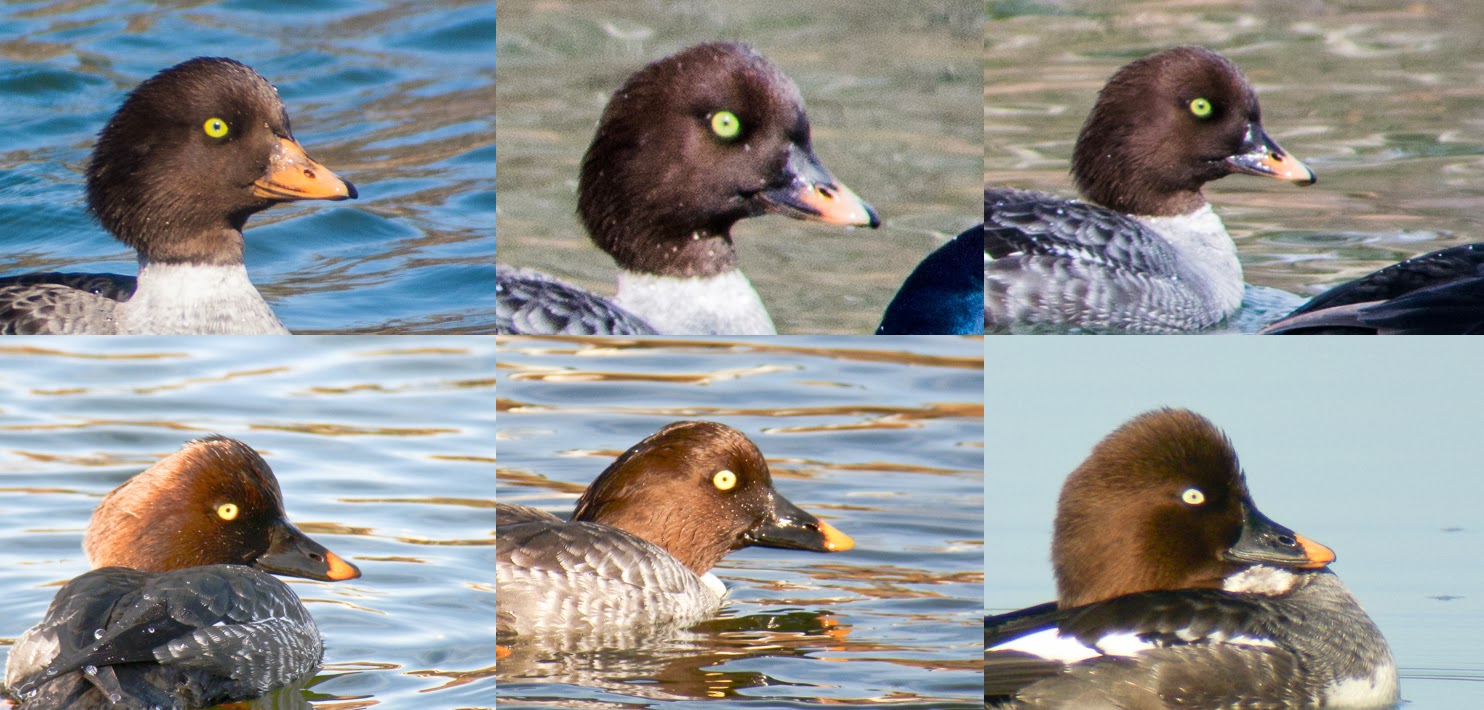At Lake Solano Park (just below where Pleasant's Valley Rd. joins Route 128), the viewing is usually good for a good variety of river ducks, and on Feb. 5 we spotted many Common Goldeneyes and a few Barrow's, both male and female, foraging in mid-stream opposite the picnic area.
The male Barrow's Goldeneye is unmistakeable, with a large white crescent on the face plus other clear diagnostic marks. The female Goldeneyes can present more of a challenge. The Barrow's female's bill is usually all orange, shorter than that of the Common Goldeneye, and "deeper" at the base, giving the bill a stubby appearance. The Common's longer bill has a different shape, which I'm still trying to get used to. When viewing a group of 3 ducks (above) at 25-30 yards, we could easily discern that one was an adult male Barrow's, and a second was an adult female Barrow's. We kind of assumed that the other female Goldeneye, with orange mainly at the distal part of the bill, must be a Common Goldeneye female. On returning home I checked the photos, and began to wonder about the puzzling female with the half orange bill, whether it was a Common or Barrow's female.
Photo 2 shows the Barrow's male with the puzzling female:
Photos 3 below shows Barrow's male and female swimming together. Of note there were Common Goldeneyes pretty close by, although these 3 keep pretty much to themselves. There were no significant courtship displays taking place.
Don't know what to make of the fact that the male's iris is the typical bright yellow, or almost yellow-orange, whereas the iris of the females here has a greenish cast to the yellow.
The guide books are somewhat limited in what they can teach about differentiating similar looking species, so I needed more information. Sibley provided just what was needed in this article from his website: http://www.sibleyguides.com/2010/01/distinguishing-female-barrows-and-common-goldeneyes/
After reviewing Sibley's article on the Sibley Guides website, I realize that such ID challenges are far from straightforward. It seems one pretty much has to disregard head shape for clues, at least regarding birds that are actively feeding, which is often the case with the Goldeneyes I see. The feathers of the head are lowered before a dive, so the profile dramatically changes and the steep forehead disappears. Same thing happens with Eared Grebes, which can have the profile of a Horned Grebe when foraging, i.e. the "steep forehead" becomes shallow, and the forward peak on the crown is lost.
Here's a very unscientific collage of some of my female Goldeneye photos, with those from Lake Solano at the top:
Top left is a typical Barrow's female, with an all orange bill that is thick at the base and a bit "stubby". The bill features a gentle curve of the lower mandible that make it almost look up-turned. The next 2 shots in the top row are of the puzzling female shown earlier above, showing what I think is a more stubby (shorter) bill than seen on the Common Goldeneyes in the row below. In the top row note the gentle curve of the lower edge of the bill, the deep/thick base, and more extensive orange than we see on the Common GE's bill. In all 3 shots we see a pretty good black "nail" at the tip of the bill.
The bottom row in the composite shows 3 female Common Goldeneyes. Note the relatively straight line along the bottom of the bill from base to tip, which can vary a bit depending on the angle of view. The orange at the tip is confined to the distal 1/3 of the bill, and the border is a clean diagonal line. The bill seems less deep at the base, seems relatively longer (less stubby), and has a small black nail at the tip. Note the great variation in head shapes among the 6 photos. Common Goldeneye females can indeed show more orange in the bill, but rarely, especially on the west coast.
Bottom line is that the consensus of "Barrow's" for the puzzling female seems to be a reasonable ID. For me the lesson is to focus on the bill. Weigh other features like head shape only if a careful comparative study can be made of birds in similar postures, such as Sibley did in Oakland some years ago. Likely he was at favorite spot for Barrow's, where Lake Merritt flows out though Laney College (area currently being restored), where the birds could be studied at close quarters.
Another lesson perhaps is to beware of any given selection of photos that are meant to prove a point, as selection bias severely limits any conclusions that can be drawn.






